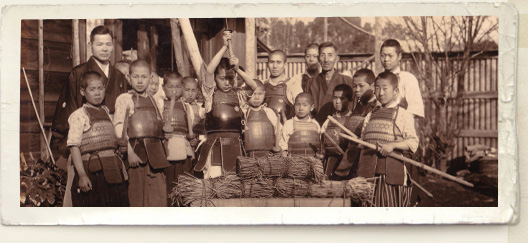
Habiki, Shinken
Shinken literally meaning "real sword", is a Japanese term used to describe a Japanese sword that is sharp and used for real cutting or combat, as opposed to those that are blunted for other types of practice. Habiki is an unsharpened sword for iai practice and for some type of paired sword forms.
 Japanese
sword is one of the traditional bladed weapons of Japan. There are several
types of Japanese swords, according to size, field of application and
method of manufacture. "Katana" was originally used as a general
term for a single-edged sword having a "sori" or curvature of
the blade.
Japanese
sword is one of the traditional bladed weapons of Japan. There are several
types of Japanese swords, according to size, field of application and
method of manufacture. "Katana" was originally used as a general
term for a single-edged sword having a "sori" or curvature of
the blade.
The katana evolved as a sleeker and more compact alternative to the tachi. (The tachi often said to be more curved and slightly longer than the katana worn edge down hung from the obi.) Its origins go at least as far back as the Kamakura Period, with several blades dated from that time residing in various national repositories.
Its growth in popularity is believed to due the changing nature of close-combat warfare. The quicker draw of the sword was well suited to combat where victory depended heavily on fast response times. The katana further facilitated this by being worn thrust through a belt-like sash (obi) with the bladed edge facing upwards. Ideally, samurai could draw the sword and strike down the enemy in a single motion. Previously, the curved tachi had been worn with the edge of the blade facing down and suspended from a belt.
Katana and wakizashi were often forged with different profiles, different blade thicknesses, and varying amounts of grind. Wakizashi were not simply scaled-down katana; they were often forged in hira-zukuri or other such forms which were very rare on katana.
The daisho was not always forged together. If a samurai was able to afford a daisho, it was often composed of whichever two swords could be conveniently acquired, sometimes by different smiths and in different styles. Even when a daisho contained a pair of blades by the same smith, they were not always forged as a pair or mounted as one. Daisho made as a pair, mounted as a pair, and owned/worn as a pair, are therefore uncommon and considered highly valuable, especially if they still retain their original mountings (as opposed to later mountings, even if the later mounts are made as a pair).
The forging of a Japanese blade typically took weeks or even months and was considered a sacred art. As with many complex endeavors, rather than a single craftsman, several artists were involved. There was a smith to forge the rough shape, often a second smith (apprentice) to fold the metal, a specialist polisher (called a togi) as well as the various artisans that made the koshirae (the various fittings used to decorate the finished blade and saya (sheath) including the tsuka (hilt), fuchi (collar), kashira (pommel), and tsuba (hand guard)). It is said that the sharpening and polishing process takes just as long as the forging of the blade itself.
The legitimate Japanese sword is made from Japanese steel "Tamahagane". The most common lamination method the Japanese sword blade is formed from is a combination of two different steels: a harder outer jacket of steel wrapped around a softer inner core of steel. This creates a blade which has a unique hard, highly razor sharp cutting edge with the ability to absorb shocks in a way which reduces the possibility of the blade breaking or bending when used in combat.
Testing of swords, called tameshigiri, was practiced on a variety of materials (often the bodies of executed criminals) to test the sword's sharpness and practice cutting technique.
